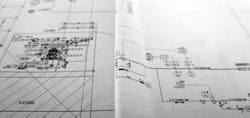It was 1988 and the discipline demanded by OSHA 1910, “Management of Change,” was not yet a focus of our profession. Instrument engineers valued expedience, and one individual accumulated a treasure-trove of useful accoutrements in the back of the Chevette he drove around the plant. Did your project run short of terminal blocks? Go see Craig. Need a 0-175 differential pressure transmitter? Craig could help you out with that. If you made some arrangements to replenish his “stores,” Craig remained a valued resource who could bail you out when late changes impacted your job.
It was a time when updating the piping and instrumentation diagram (P&ID) was often forgotten or neglected. Plant and corporate staffs were not as “lean” as they’ve become in the current century. But still, the problems to solve and the ad-hoc distractions of a running plant meant only a minority of meticulous engineers took the time to document their changes.
Since OSHA 1910 process safety management (PSM) became an enforced regulation in the 1990s, having an up-to-date P&ID has been critical to ongoing process hazard analysis, also known as PHA-HAZOP (HAZard and OPerability) study. These painstaking studies, updated at least every five years, routinely document mitigation of hazards afforded by instrumented systems.
Hazards can manifest in a variety of categories. Each enterprise defines the level of risk that requires an adequate countermeasure. The sensitivity to risk can evolve over time, usually becoming more conservative. Concerns about increasingly inexperienced or less engaged employees are affecting management’s peace of mind.
So, it follows that if the P&ID is the document guiding the PHA-HAZOP team through its evaluation, it must show instruments, controls and interlocks used to address the risks identified. But in today’s world, Craig’s modern counterpart has a trunk full of wireless monitoring and optimization (M+O) sensors and transmitters. Some of these are already finding their way into the HAZOP.
An operator found he could repurpose a wireless acoustic and temperature sensor to alert him to a pump in which viscous process fluid was plugging its kickback. It was never shown as such on the P&ID. Does it need to be? The large reciprocating compressor has multiple sensors on every cylinder, of great interest to the rotating equipment specialist and arguably a safeguard against financial losses, but none are on the P&ID.
Will these incidental measurements clutter the P&ID to a degree that genuine hazards are more challenging to recognize? Clearly there’s a category of M+O measurements that will be shown on the P&ID. These are items that operators want to monitor to fend off complications during their shift, such as a cold line that should have heat tracing active or a pump whose motor amps are approaching a limit.
Meanwhile, our supplier community is creating a repertoire of instrumentation that's temptingly expedient and inexpensive to deploy. When one installs a wireless pressure gauge in place of a mechanical one is a P&ID update needed? Surface temperature sensors, acoustic and vibration devices can be installed with hose clamps. Are we wrong to unleash the end user—the operator—to find applications that are immediately useful to them?
One suggestion would be to apply an alarm rationalization metric. Can we configure an alarm that alerts the operator to an abnormal condition and requires a timely operator response? I'd contend that a response like sending an email to the area maintenance supervisor doesn’t meet the definition of timely, while arguably switching to a spare pump or decreasing flow until vibration intensity is reduced does meet it.
We’ll need to show auditors we have guidelines for determining when a measurement needs to be on the P&ID. The shoot-from-the-hip freedom of past decades doesn’t fly today, so gather your free-wheeling and imaginative IIoT end users and standardize cases where traditional document updates are warranted.
About the Author

Leaders relevant to this article:

